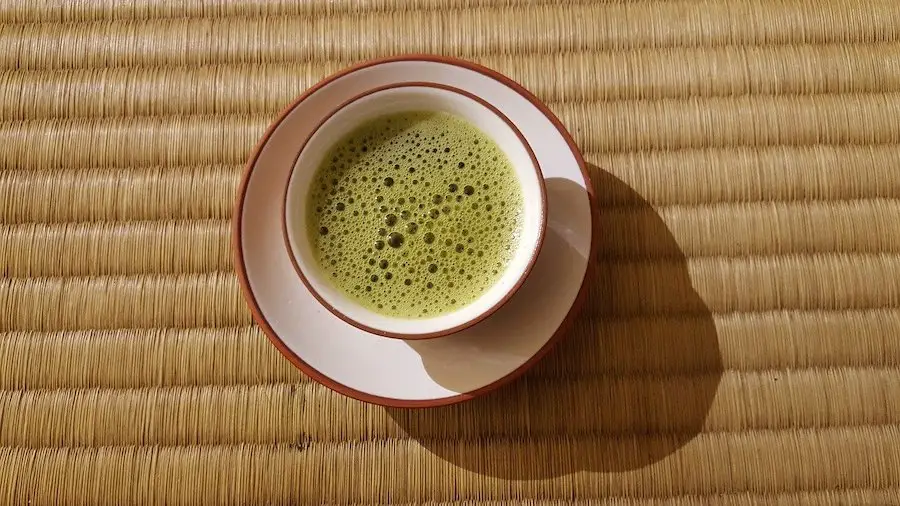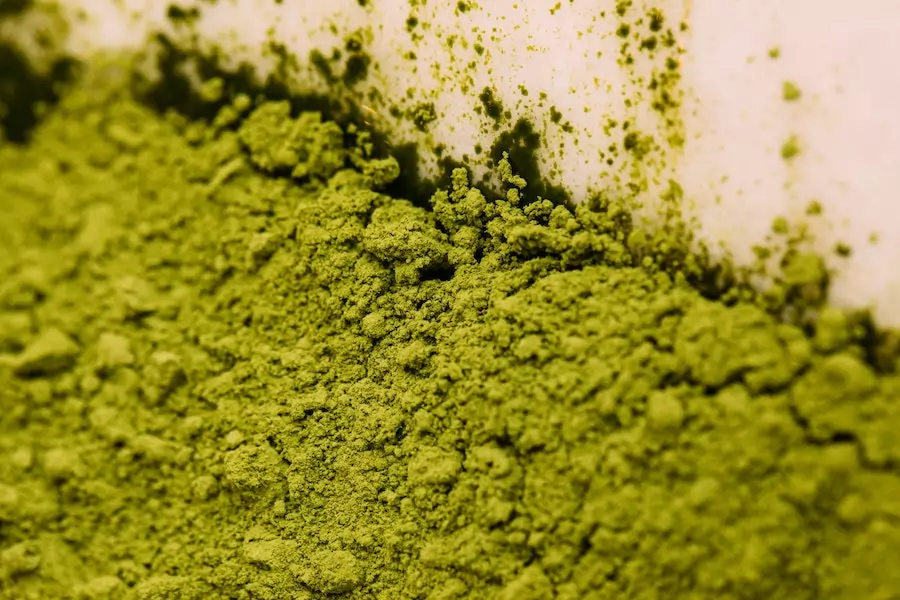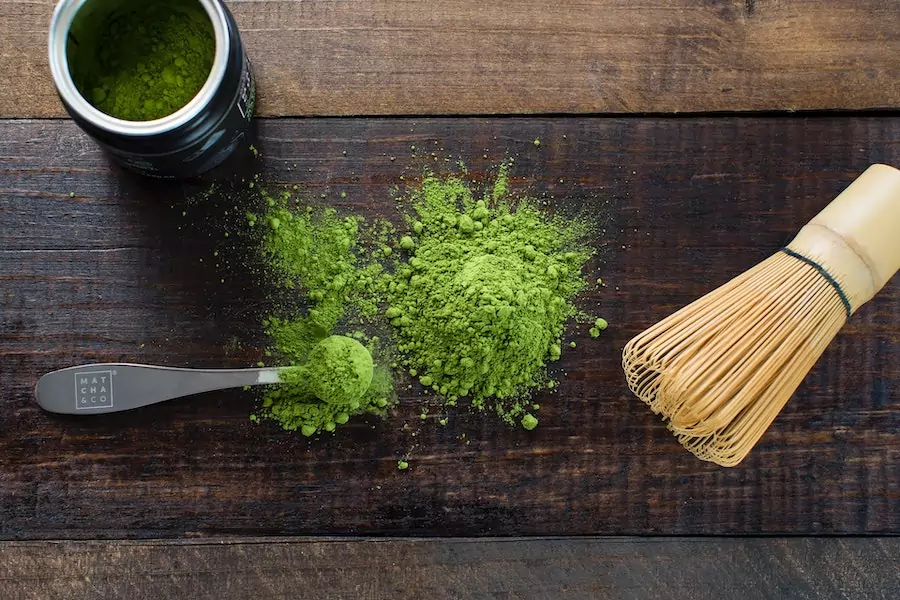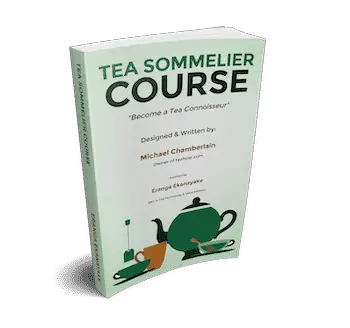Hello, all you budding beautiful tea lovers! In this article – what is matcha, I’m going to answer exactly that… what is matcha! Simple!
I’ll focus mainly on what matcha is, its types, and how it’s produced. As well as buying and storing matcha, and how to prepare it for drinking.
To begin with though, in short…
Matcha is a form of green tea. It’s made by grinding up high-quality green tea leaves to a fine powder. Matcha has an incredible depth of flavor. It’s what is used to make the famous Japanese tea ceremony so special. A lesser quality version is usually used in culinary practices.
So let’s get into more details…
What is matcha?
Matcha is more than just a beverage though. It’s been utilized for medicinal uses in China for thousands of years and in Japan during the 12th century by Buddhist monks.
Matcha is a great source of what is known as catechins. Catechins are antioxidants said to lower cholesterol, fight cancer and boost metabolism among other things.
Before we get into what matcha tea is made from, let’s touch on how it’s produced. This will help you understand what matcha is and how it differs from almost all other brewed teas. For those historians among you, you might want to check out the history of tea.
Matcha means…
AKA: 抹茶, maccha, macha or “fine powder tea”
The word “matcha” refers to the finely milled, bright green powder of specially grown and processed green tea leaves. Its color is vivid, its flavor deep, often earthy, and vegetal yet mellow. And sometimes matcha has just a touch of sweetness.
The thickness of the froth that forms when matcha is whisked into hot water makes it particularly well suited for tea ceremonies.
And it just oozes goodness and benefits. You may well feel like the healthiest person on earth when you drink it.

Types of matcha
Types of matcha include two variations of ceremonial-grade matcha, and cooking-grade (or food-grade_ matcha.
Here are the two types of matcha you’re likely to come across
Culinary grade matcha
Also known as “cooking grade matcha” or “food grade matcha”. This grade is the lowest quality available, while food-grade is usually reserved for blending into smoothies or desserts.
If you’re looking for something to sprinkle on top of your baked goods or mix into smoothies, this matcha is right for you.
While not the finest quality baking-grade matcha powder, it still works well for adding color to food or drinks. But it can produce more of a bitter taste than what you would usually want in your tea.
Ceremonial matcha
This is what’s used in traditional tea ceremonies and what you’re likely to be served in a Japanese restaurant. It’s often what is ordered in a tea house. It’s also what’s used when whisking matcha into a bowl of hot water to make the tea.
Matcha comes from the best, most tender leaves of “shade-grown”, organically grown tea plants.
Real ceremonial-grade matcha is the whole ground powder of specially selected leaves that have been steamed and dried immediately after plucking. These are usually used for matcha or sencha.
They are stone-ground into what is called a fine powder and whisked with hot water. The liquid that comes from this process is what we finally refer to as ceremonial-grade matcha.
In terms of quality, you can basically break ceremonial matcha into two categories. Those two are budget – or standard drinking quality, and premium. More on purchasing shortly.

How matcha is produced
Matcha has been around for centuries and it’s made by grinding up shade-grown tea leaves into a very. Traditionally, matcha was produced by hand
Matcha vs Tencha
Tencha is the name for tea leaves that are used for making matcha – before being ground into a fine powder. Ten stands for “mortar” or “grind”, referring to the making process and “cha” is tea. Most Tencha is processed into matcha, but it may also be consumed in its raw form.
The flavor of Tencha, produced in the same manner as Gyokuro, is considered distinctive and pure in taste, noble, and attractive for many health reasons. The tea is pale green, with a deep and delicious flavor. The delicate noble scent lingers in the mouth for a time.
Buying matcha
when buying matcha, you first need to understand what the intended use is. i.e. culinary, or ceremonial.
The culinary grade tea is only meant to be used in cooking. Always avoid what is labeled as “culinary” or “budget” matcha powder, these are the ones you want to stay away from unless you’re using sparingly in the cooking process.
These powders often contain a lot of ingredients other than green tea, such as sweeteners and flavorings, making them less flavorful and less healthy.
Ceremonial grade matcha is what you will be using in the ceremonial tradition of drinking matcha green tea. This matcha is what we suggest purchasing if you want to drink it every day for its health benefits or make a beautiful bowl of matcha at home.
When it comes to what should you look for when buying matcha powder, as I alluded to earlier there are a few types.
Matcha grades can be broken down into three categories; culinary, or “cooking” matcha powder, and then ceremonial grade which is either standard or premium ceremonial matcha.

Type of matcha to buy for drinking
In terms of what type you should buy, what grade, what is the best matcha brand? We suggest you start with a Ceremonial grade if your main intention is for drinking matcha.
If you’re considering drinking matcha from a mixing bowl. My recommendation is to go straight for the premium ceremonial.
If you’re new to matcha, a lower grade or what I’d refer to as “standard” ceremonial matcha is not likely to taste as good and to put you off the idea. So start with the best and then drinking standard matcha later won’t seem like a poor initial experience.
Storing matcha
Matcha is best used as soon as possible after its production …and after you’ve purchased it as oxygen exposure will start to oxidize and deplete the taste and integrity of the mix. So don’t purchase too much at once. here’s my full post on whether matcha expires.
If you do need to store matcha, it is best to seal matcha in an airtight, opaque container and store it in a cool, dark place.
For extended periods (6 months or more) I’d recommend keeping your matcha in the fridge and bringing it out and letting it warm up for 15 minutes or so before drinking.
If you like matcha and intend to purchase it regularly, then consider having it on a subscription basis. Then, you can choose better quality matcha from a reputable store, and have it delivered monthly.
A reputable company cares about quality. So they should be able to tell you where it was grown and when …at the very least. Sometimes they can tell you even more, like which farm it came from and the elevation it was grown at!
Preparing matcha
Preparing matcha is what I would call a ritual. It is what makes the matcha so special when you sit down and enjoy it in your home.
Matcha in Japan is what people have in their cups when they engage in ceremonial and special occasions. It’s what you might like to enjoy on your wedding day, or what you dedicate yourself to in zen Buddhism.
To prepare matcha in Japan it is best done in a ceramic bowl called a chawan. This way the warmth of the chawan can be felt when holding it with both hands and drinking it.
What do I need to start making matcha?
The best place to head for initially is amazon. You can get some starter kits that give you everything you need.
But I’d always say avoid those that come with the matcha leaves in the pack unless it’s an expensive kit, or it’s just a sample you can perhaps discard.
They’re rarely very good quality in my opinion. You’re better off buying your matcha separately. Here are a couple of links from amazon I’d recommend.
Matcha starter kit (includes everything you should need apart from the Matcha)
Premium grade matcha (remember, this is higher grade, higher quality tea)
And it would be remiss of me if I didn’t mention my tea course at this point. It’s not a dedicated matcha course as such. But covers a lot of tea education and beginner techniques. I’ve aimed to get you fast knowledge and getting into the tea tasting. All done without hours of exams and lots of money spent on official courses! It’s well worth a look!

Take the fast track and become a tea connoisseur
Whether for enjoyment or considering a career as a tea sommelier. This course has everything you need to enhance your tea knowledge and tea-tasting skills.
This course keeps it simple with step-by-step tea tasting and easy reference guides
For pleasure, or as a precursor to a career in the tea industry. Find out what tea sommelier actually does, their career paths, and what they earn.

Find out more about the Teahow Tea Sommelier Course!
Preparing matcha
Matcha is prepared quite differently from many of the brewed teas you may have had before. But it’s very easy to make if you have the right tools – especially those I’ve mentioned above.
The tools and ingredients you’ll need to make matcha
- Matcha powder
- Chawan
- Whisk
- Kettle or pan
- Cup or glass
- teaspoon
- water.
The 4 steps to making perfect matcha
So now you have your tools, follow these easy steps
Step 1: bring 1/3 cup to the boil and let it cool
Bring 1/3 cup (100 mg) of filtered water or spring water to a boil in a pan or kettle. Remove it from heat and let cool for around 2 to 3 minutes.
Step 2: Add 1/2 teaspoon of matcha and stir with a splash of water
Add 1/2 teaspoon matcha powder into a small bowl (your chawan). Add an initial splash of the hot water and mix with the bamboo whisk to form a smooth paste, being sure to break up any lumps.
Step 3: Add remaining water and whisk to a frothy foam
Once any lumps have been broken down, add the remaining water to your chawan and stir with the bamboo whisk, flicking the whisk vigorously back and forth, until matcha is absorbed by the water and you get a frothy thin foam on the top.
Step 4: Drink all the brew directly.
Nothing else needed, either drink from the chawan or decant to a glass and drink. You can also add some seasonal Japanese confectioneries to sweeten and then all that remains ….is to be “zen”!
Oh, that reminds me, check out my article on Zen tea!
Hints and tips to preparing matcha
- Matcha is a different taste to most other teas. It might be a good idea to drink traditional green teas prior to trying matcha to become more familiar with the taste profile.
- It’s easier to get the frothy texture with the bamboo whisk, but if you don’t have one then a kitchen whisk or even a fork will create some of the effects.
- Matcha powder becomes far more bitter and tastes more like an astringent when it’s “burnt”. So absolutely let the boiling water cool off slightly before pouring
- Experiment with the thickness till you find your most tasteful spot. Do this by varying the water quantity. a 1/4 of a cup creates thicker matcha and 1/2 cup of water for a thinner mix.
- To create latte matcha, soy milk, coconut milk, or almond milk can all be used as a replacement for water.
- To get iced tea matcha, simply pour your prepared matcha over a glass filled with ice and voila, “iced matcha”.
- No need to buy lots of fancy equipment, try it with some basic tools you have in your kitchen before diving into building your chawan and whisk collection!

Taste of matcha
If you’ve made your matcha correctly, what you’ll have in your cup is a very bright-green liquid with a slight yellow tint.
The taste should be strong and bitter, even grassy and vegetal to a degree. If it’s sweet, then you’ve added too much water or milk to the matcha powder. But that could be done intentionally based on your preference.
The bitterness increases as you drink more of the tea. And it’s perfect for those who want a bit of a caffeine kick.
You can add some milk and sugar if you wish. This is what some of the Japanese have been adding for centuries. You could even add honey.
It also works well as a syrup. So you can drizzle some over ice cream or fruit – or anything that could benefit from adding sweetness and fresh flavor. (I added it to a miso-caramel sauce in a recipe once. The sweetness married perfectly with the salty, rich flavors).
Matcha is what’s known as a “superfood,” especially if you’re ingesting it frequently since it’s what gives green tea powder its anti-oxidant powers. It works well to boost your metabolism and energy. There are actually so many benefits to drinking matcha regularly.
It’s worth noting regarding the caffeine hit, that matcha does contain caffeine. You can find out more about caffeine in matcha here.
So that should answer …what is matcha!
I hope this has given you some insight into what matcha is. Hopefully, it’s the definitive information around buying it, storing it, the types, preparing it, and some “secret sauce” along with it! You might also like to know more about white tea vs matcha. Or what to do about bitter green tea.
And don’t forget to check out my tea sommelier course! You’ll love it!
